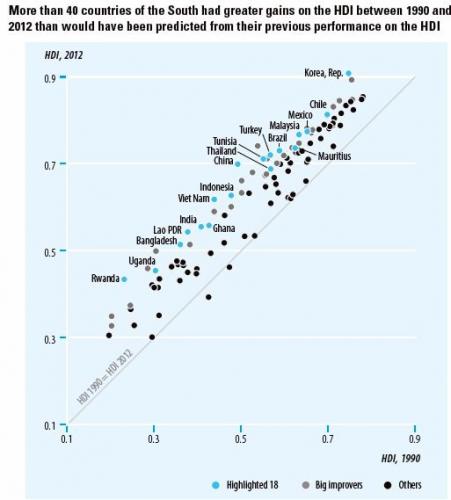FEATURE: Developing countries experiencing unprecedented growth, says UN report
The rapid growth of developing countries is propelling millions out of poverty on an unprecedented scale and radically reshaping the global system, according to a flagship United Nations report launched Thursday.

Rice fields in Sichuan, China.
“The rise of the South is unprecedented in its speed and scale,” says the Human Development Report 2013, which uses the term “South” to mean developing countries and “North” to mean developed nations. “Never in history have the living conditions and prospects of so many people changed so dramatically and so fast.”
Meanwhile, the slowdown in economic growth, austerity measures and rampant unemployment in the industrialized world has brought pressure to bear on governments and societies in the North. Global economic and political structures are in flux and the sustainability of the growth spurt in the South is subject to the interrelated issues of governance and public investment.
The year’s report, entitled The Rise of the South: Human Progress in a Diverse World, emphasizes that this change represents a global rebalancing far greater than that experienced during the Industrial Revolution, with the South becoming the main driver of economic growth and societal change for the first time in centuries.
“The Industrial Revolution was a story of perhaps 100 million people, but this is a story about billions of people,” said Khalid Malik, the report’s lead author.
The Human Development Report, released annually by the UN Development Programme (UNDP), assesses the state of human development on the basis of health, education and income indicators, as an alternative to purely macroeconomic assessments of national progress.
The initial report was published in 1990 by its authors, the late Mahbub ul Haq and Amartya Sen, and introduced a Human Development Index (HDI), which had been calculated by UN economists from 1975, and was essentially a ranking of countries based on strides made with a people-centric model of progress.
The HDI became an influential paradigm that would prod economists, government agencies, planners and development experts to rethink the income-based indicators that were in standard use to measure development success.
Launched Thursday in Mexico City by UNDP Administrator Helen Clark and Mexican President Enrique Peña Nieto, this year’s report singles out big economies which have shown significant growth over the past 20 years, namely China, India and Brazil. It estimates that by 2020, the combined output of these three countries will surpass the aggregate production of the United States, Germany, United Kingdom, France, Italy and Canada.
However, the ‘rise of the South’ goes well beyond these economies as more than 40 developing countries have made greater human development gains in recent decades than what was predicted.
Countries such as Indonesia, Mexico, Bangladesh, Tanzania and Yemen all registered significant growth, while nations such as Afghanistan and Pakistan had some of the fastest growth rates in the world with 3.9 per cent and 1.7 per cent over the past 12 years, respectively.
How has the South achieved such dramatic growth levels?
The report attributes many of the achievements of the South to smart national strategies that have allowed them to engage in the global economy while at the same time implementing social programmes that protect those most vulnerable.

Men winnowing rice in southern India.By 2020, the report estimates that the combined output of China, India and Brazil will surpass the aggregate production of the United States, Germany, United Kingdom, France, Italy and Canada.
“Economic growth alone does not automatically translate into human development progress,” Miss Clark says in the report’s foreword. Southern States are therefore not just tapping into global trade, but they are also improving health and education services, which have allowed them to sustain their growth. This comes in contrast to policies adopted by many developed countries which include austerity measures and cutting social programmes due to the economic crisis.
In Latin America, many countries have put in place programmes to eradicate poverty and address inequality such as Brazil’s Bolsa Familia, Mexico’s Oportunidades, and Chile’s Chile Solidario. These are conditional cash transfer programmes which offer to increase people's income as long as they fulfil certain conditions such as visits to health clinics and school attendance.
This combination of policies has allowed the middle class in the South to expand and, by 2030, the report projects that more than 80 per cent of the world’s middle class will reside in developing countries and account for 70 per cent of total consumption expenditure.
Increasing online and mobile connectivity in the South
Increasing connectivity thanks to greater access to technology is also a factor that has contributed to the South’s growth. Globally, Brazil, China, India, Indonesia and Mexico have more daily social media traffic than any country except the US. China also has more than half a billion people accessing the Internet daily through smart phones.
Indonesia, for example, invested extensively to connect its large cluster of far-flung islands to open the country to the outside world, and as of 2010, 220 million mobile phones were registered in a country of 240 million people.
In Africa, Asian-built mobile phones have made cellular banking cheaper and easier, while leading to better market performance and increased profits by small farmers, as seen in Kenya, Niger and Uganda.
Increasing incomes and the diffusion of technology have also given way to a more informed middle class that has social and political expectations, Mr. Malik said in a press briefing on Tuesday, which means that “the relationship between the State and its citizens is changing.”
He warned that if States are not mindful of these expectations, it could lead to social instability, as was the case in 2011 in various countries across the Middle East.
“The turmoil in several countries in the Arab States is a reminder that people, especially the young, who are better educated and healthier than previous generations, put a high premium on meaningful employment, on exercising a voice in affairs that influence their lives, and on being treated with respect,” the report says.

Booming South-South partnerships
The report highlights the increase in South-South trade and partnerships and projects that trade between them will overtake that between developed nations.
“Emerging partners in the developing world are already sources of innovative social and economic policies and are major trade, investment and increasingly development cooperation partners for other developing countries,” Miss Clark said.
China is already influential in Africa through trade investment as well as through assistance and cooperation. Between 1992 and 2011, China’s trade with Sub-Saharan Africa rose from $1 billion to more than $140 billion.

India is increasingly playing a larger role as a supplier of affordable capital goods to other countries of the South. For instance, Indian firms are supplying affordable medicines, medical equipment and information and communications technology (ICT) products and services to many countries in Africa.
In addition, migration between developing countries has recently surpassed net migration from South to North. “In our changing world, solutions are moving across the South, not from the North to the South,” said UNDP Regional Director for Asia and the Pacific, Ajay Chhibber.
However, a substantial share of South-South trade is driven by demand in the North. For example, since 2007, US exports to China and Latin America and the Caribbean have grown two and a half times faster than US exports to traditional markets in the North. A growing “app economy” supported by companies such as Apple, Facebook and Google employs more than 300,000 people whose creations are exported across borders, and developing country economies continue to be sensitive to shocks in the industrialized world.
Women’s education as a silver bullet for sustainable growth
While there has been remarkable progress, the report warns that there are still many challenges ahead for countries in the South, including an ageing population, environmental degradation and inequality. Poverty and inequality are particularly worrying, as an estimated 1.57 billion people, representing 30 per cent of the population in the 104 countries studied for the report, still live in multidimensional poverty.
The report provides a series of recommendations and, in particular, highlights education for girls as “the closest thing to silver bullet formula for accelerating human development.”
Many of the countries in the South still have dramatic gender disparities, and their challenge will be to boost efforts to allow women to participate freely in all aspects of their society.
“Gender inequality is especially tragic not only because it excludes women from basic social opportunities, but also because it gravely imperils the life prospects of future generations,” the report says, referring to findings which correlate women’s education to greater child survival, healthier children and better access to contraception.
The report also notes that the global system will need to adjust itself to the rise of the South, which is currently largely underrepresented in global institutions. For example, China, which is the world’s second largest economy, has had a smaller voting share in the World Bank than either France or the United Kingdom.
“Stronger voices from the South are demanding more representative frameworks of international governance that embody the principles of democracy and equity.”
Meanwhile, it merits mention that not all countries in the South are racing ahead. Of the world’s 49 Least Developed Countries, many are lagging behind in this revolution. Even as some are beginning to benefit from Foreign Direct Investment of the emerging giants like China, India and Brazil, there is much more to be done in terms of development transformation.
The report observes that there are three drivers of transformation: a proactive development state, tapping of global markets and determined social policy inclusion. Looking back at the inception of the HDI, it appears that countries that started at the same level – India and Pakistan, or Chile and Venezuela, or Liberia and Senegal – have ended up with different outcomes.
“History and initial conditions matter, but they are not destiny,” according to the report.
Source: UN News
- 406 reads
Human Rights
Ringing FOWPAL’s Peace Bell for the World:Nobel Peace Prize Laureates’ Visions and Actions

Protecting the World’s Cultural Diversity for a Sustainable Future

The Peace Bell Resonates at the 27th Eurasian Economic Summit

Declaration of World Day of the Power of Hope Endorsed by People in 158 Nations

Puppet Show I International Friendship Day 2020

